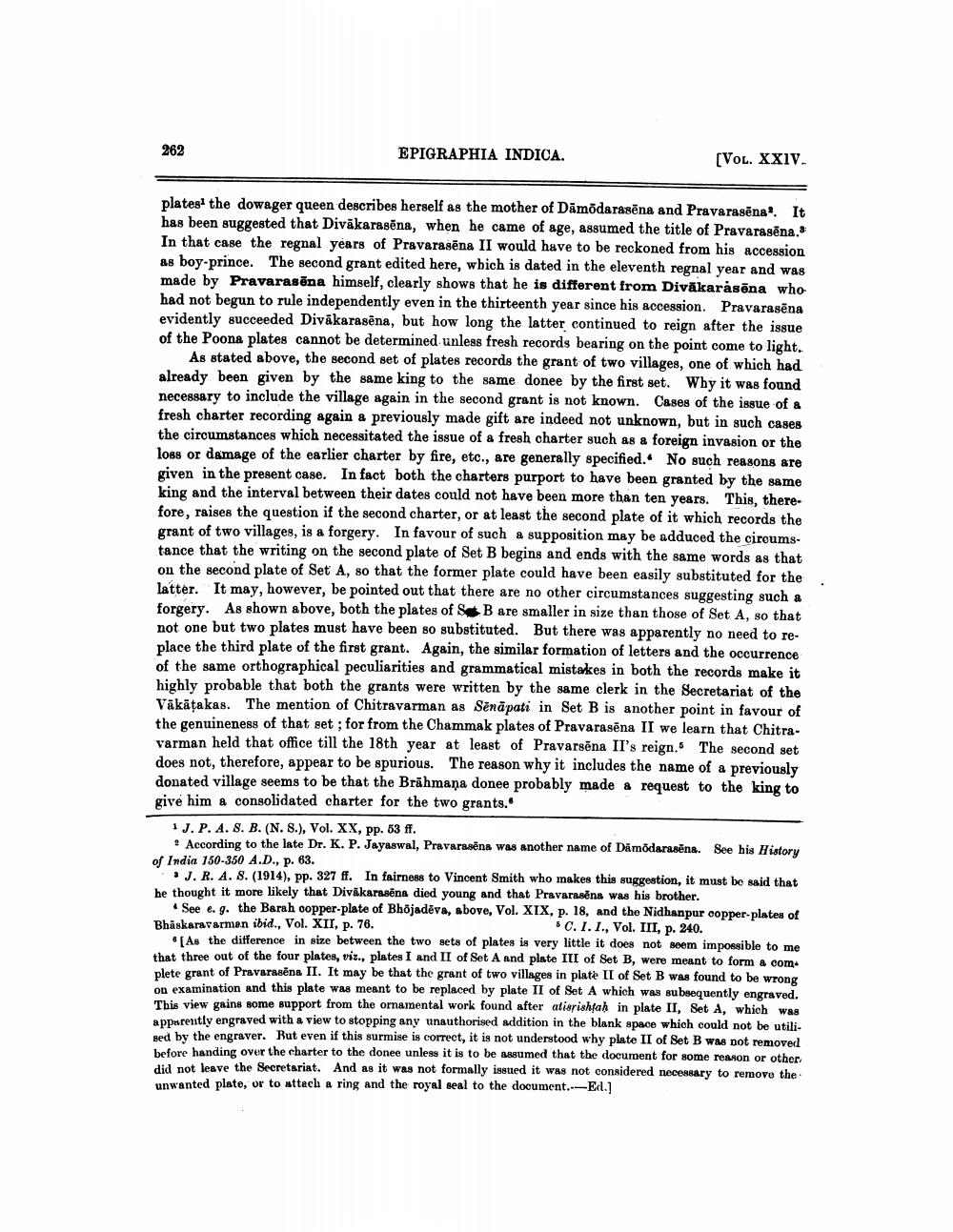________________
262
EPIGRAPHIA INDICA.
[VOL. XXIV.
plates the dowager queen describes herself as the mother of Damodarasena and Pravarasēna". It has been suggested that Divakarasēna, when he came of age, assumed the title of Pravarasēna. In that case the regnal years of Pravarasēna II would have to be reckoned from his accession as boy-prince. The second grant edited here, which is dated in the eleventh regnal year and was made by Pravarasēna himself, clearly shows that he is different from Divakarasōna who had not begun to rule independently even in the thirteenth year since his accession. Pravarasēna evidently succeeded Divakarasēna, but how long the latter continued to reign after the issue of the Poona plates cannot be determined unless fresh records bearing on the point come to light.
As stated above, the second set of plates records the grant of two villages, one of which had already been given by the same king to the same donee by the first set. Why it was found necessary to include the village again in the second grant is not known. Cases of the issue of a fresh charter recording again a previously made gift are indeed not unknown, but in such cases the circumstances which necessitated the issue of a fresh charter such as a foreign invasion or the loss or damage of the earlier charter by fire, etc., are generally specified. No such reasons are given in the present case. In fact both the charters purport to have been granted by the same king and the interval between their dates could not have been more than ten years. This, therefore, raises the question if the second charter, or at least the second plate of it which records the grant of two villages, is a forgery. In favour of such a supposition may be adduced the circumstance that the writing on the second plate of Set B begins and ends with the same words as that on the second plate of Set A, so that the former plate could have been easily substituted for the latter. It may, however, be pointed out that there are no other circumstances suggesting such a forgery. As shown above, both the plates of SB are smaller in size than those of Set A, so that not one but two plates must have been so substituted. But there was apparently no need to replace the third plate of the first grant. Again, the similar formation of letters and the occurrence of the same orthographical peculiarities and grammatical mistakes in both the records make it highly probable that both the grants were written by the same clerk in the Secretariat of the Vākāṭakas. The mention of Chitravarman as Senapati in Set B is another point in favour of the genuineness of that set; for from the Chammak plates of Pravarasena II we learn that Chitravarman held that office till the 18th year at least of Pravarsēna II's reign. The second set does not, therefore, appear to be spurious. The reason why it includes the name of a previously donated village seems to be that the Brahmaņa donee probably made a request to the king to give him a consolidated charter for the two grants.
1 J. P. A. S. B. (N. S.), Vol. XX, pp. 53 ff.
According to the late Dr. K. P. Jayaswal, Pravarasena was another name of Damodarasēna. See his History of India 150-350 A.D., p. 63.
J. R. A. S. (1914), pp. 327 ff. In fairness to Vincent Smith who makes this suggestion, it must be said that he thought it more likely that Diväkarasëna died young and that Pravarasena was his brother.
See e. g. the Barah copper-plate of Bhöjadeva, above, Vol. XIX, p. 18, and the Nidhanpur copper-plates of Bhaskaravarmen ibid., Vol. XII, p. 76. 5 C. I. I., Vol. III, p. 240.
[As the difference in size between the two sets of plates is very little it does not seem impossible to me that three out of the four plates, viz., plates I and II of Set A and plate III of Set B, were meant to form a com plete grant of Pravarasena II. It may be that the grant of two villages in plate II of Set B was found to be wrong on examination and this plate was meant to be replaced by plate II of Set A which was subsequently engraved. This view gains some support from the ornamental work found after atisrishtah in plate II, Set A, which was apparently engraved with a view to stopping any unauthorised addition in the blank space which could not be utilised by the engraver. But even if this surmise is correct, it is not understood why plate II of Set B was not removed before handing over the charter to the donee unless it is to be assumed that the document for some reason or other. did not leave the Secretariat. And as it was not formally issued it was not considered necessary to remove the unwanted plate, or to attach a ring and the royal seal to the document.--Ed.]




